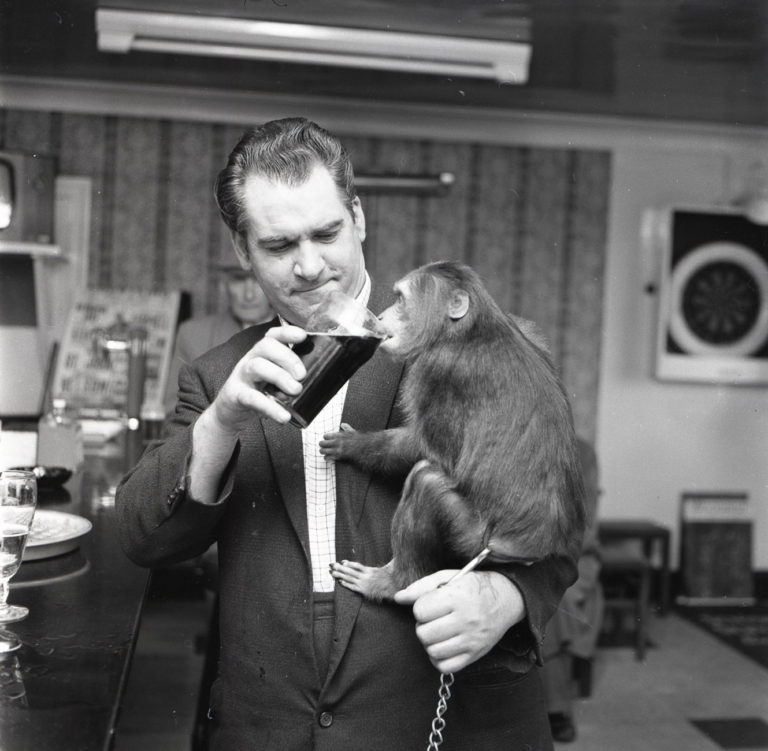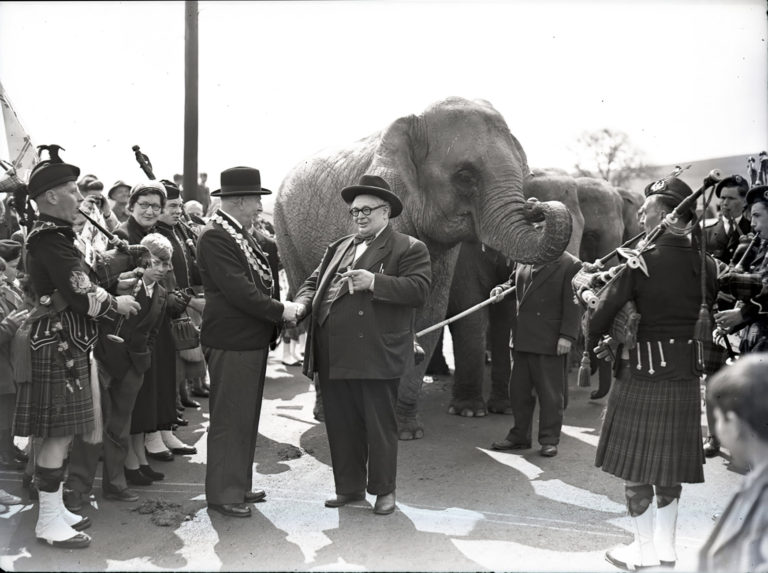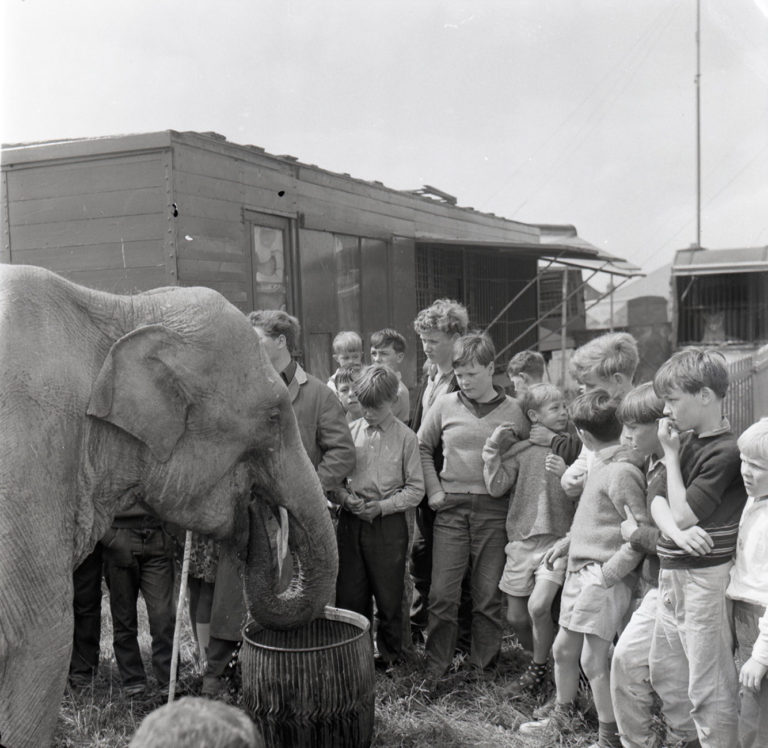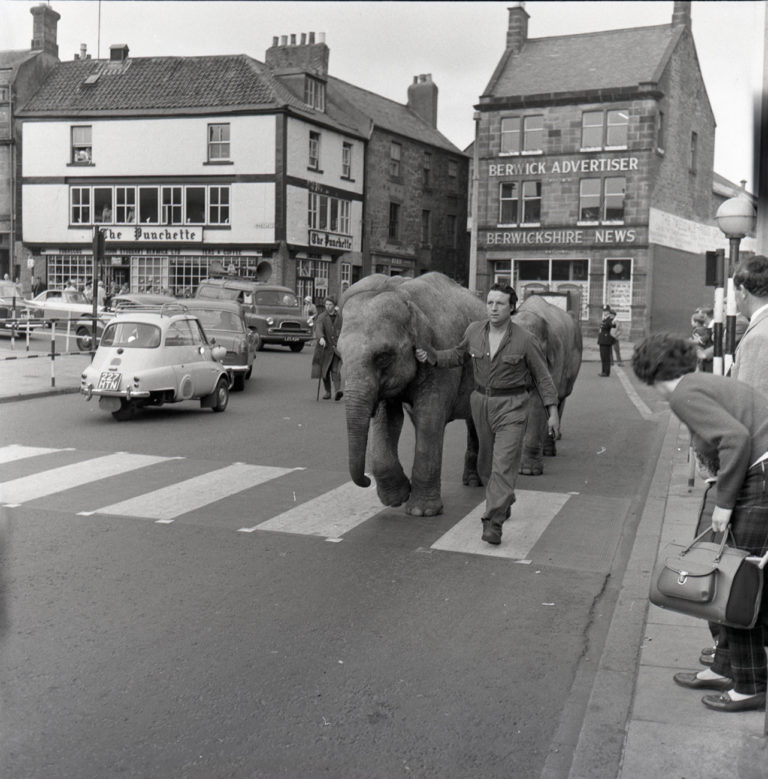Photographs of Animals, 1954-1967
Reference: BRO 1944/1/4542/24, BRO 1944/1/623/3, BRO 1944/1/4851/55, BRO 1944/1/3214/7
Suggested age groups: KS2, KS3, KS4, KS5, Lifelong Learners
Subject areas: Photography, Documentary Photography, Photojournalism
CONTEXT
Originally founded in 1951 as the Photo-News Service, the Photo Centre in Berwick was a staple of town life for over 65 years as a family-run press agency and photo studio.
Their premises at 17 Bridge Street had a well-equipped studio above the shop where commercial photography took place. The business also covered newsworthy events in the area and recorded family occasions and celebrations, marking milestones in the lives of several generations of townspeople.
The first photograph (BRO 1944/1/4542/24) shows Mr Sim holding his pet monkey which is drinking from a pint glass at The Blenheim in Spittal in 1966.
The second photograph (BRO 1944/1/632/3) was taken on 23rd May 1954. En route to Scotland, circus owner Billy Smart led a procession of 10 elephants from Berwick station to the Scottish Border accompanied by nearly 150 local children. At Lamberton Toll, they were greeted by pipers and the Mayor of Berwick, Alderman G.M. Lamb. The elephant procession then returned to Berwick to reboard the train for Edinburgh.
The third photograph (BRO 1944/1/4851/55), which was taken in June 1967, shows a group of children saying goodbye to Suzette the elephant who was leaving for Spain.
The fourth photograph (BRO 1944/1/3214/7) is from 14th June 1961. Elephants from Robert Brothers’ Circus paraded through Berwick when they arrived for a 2-day visit. They walked along Golden Square, across the Royal Tweed Bridge to Tweedmouth where their Big Top tent was set up. It seated over 2000 people. Before the last show had even finished, the elephants were already being led back through the streets to the railway station.
Photojournalism is a type of journalism that uses images to tell a news story. Photojournalism usually refers to photographs, but sometimes the term can be used to describe videos used in broadcast journalism.
Photo essays are a form of visual storytelling, presenting a narrative through a series of images. Photo essays can be powerful ways to evoke emotion and understanding without using words.
Documentary Photography is an umbrella term encapsulating a wide range of approaches; however the term usually refers to art which captures a real moment, conveying a message about the world. It provides a straightforward and accurate representation of people, places, objects, and events, and is often used in reporting.
ARTISTS BANK
Kitra Cahana
Kitra Cahana is a documentary photographer, photojournalist, and photo/video artist. She is a contributing photographer for National Geographic Magazine and a TED speaker. She has produced a number of photo-essays and documentary videos on various different subjects both for National Geographic and as a freelance photographer. She has won awards for investigative journalism.
Portfolio: https://kitracahana.com/
Stephanie Sinclair
Stephanie Sinclair is known for producing photographic essays about the most sensitive gender and human rights issues around the world. She has documented the defining conflicts of the last decade, and covered the everyday brutality faced by young girls in developing countries around the world.
Portfolio: https://stephaniesinclair.com/
Steve McCurry
Steve McCurry is an American photojournalist. He has covered many armed conflicts particularly in the Middle East and Asia. Many of his photographs concentrate on the toll war takes on humans. His most famous photograph is Afghan Girl (1984), depicting a young girl named Sharbat Gula at the Nasir Bagh refugee camp on the border of Afghanistan and Pakistan.
Portfolio: https://stevemccurry.com/
Rena Effendi
Rena Effendi is a social documentary photographer. Her works tend to focus on stories that are either well-known or underrated, her early work focused on the oil industry and how it effects people’s lives. She also has photographic series responding to wildlife conservation and environmental decay.
Portfolio: http://www.refendi.com/
Lynsey Addario
Lynsey Addario is an American photojournalist. Her work often focuses on conflict, human rights issues, and the role of women in traditional societies. In the early 2000s she traveled to Afghanistan under Taliban rule to document life and oppression under the Taliban.
Portfolio: http://www.lynseyaddario.com/
ACTIVITIES
ACTIVITY 1
Background
Documentary Photography is an umbrella term encapsulating a wide range of approaches; however the term usually refers to art which captures a real moment, conveying a message about the world. It provides a straightforward and accurate representation of people, places, objects, and events, and is often used in reporting.
Photojournalism is a type of journalism that uses images to tell a news story. Photojournalism usually refers to photographs, but sometimes the term can be used to describe videos used in broadcast journalism.
SEE
See: What is documentary photography?
See: What is being documented in these photographs?
See: What is photojournalism?
See: What news stories are being told in these photographs?
THINK
Think: What is the difference between documentary photography and photojournalism?
Think: Is documentary photography ethical?
Think: Is it right for a documentary photographer to manipulate the image to convey their message?
Think: Do documentary photographs always convey the truth?
Think: Should documentary photographers intervene in the scene? E.g. The Vulture and the Little Girl – Kevin Carter (1993) and Napalm Girl – Nick Ut (1972).
Think: Are there some scenes that shouldn’t be documented?
Think: What kind of social impact can documentary photographs and photo essays have?
Think: Does photojournalism ever exploit people in vulnerable situations? You could consider Migrant Mother by Dorothea Lange and Afghan Girl by Steve McCurry.
DO
Do: Analyse each of the photographs showing animals in Berwick. What can you infer from each?
Do: Write a newspaper article to accompany one of the images describing the events that have taken place.
Do: Choose a person from one of the photographs. Write a journal entry from their perspective of the events leading up to, during, and after the photograph was taken.
Do: Choose a documentary or photojournalism photographer to look at. Analyse their work and make a profile to record the areas of documentary photography and photojournalism they have worked with.
Do: Choose a photograph or photo series created by your chosen photographer without reading the background context of the image. Think about the phrase “a picture is worth a thousand words”. Make a list of all of the words that you associate with your chosen photograph. This could include words that describe what is taking place in the photograph; who, what and where the image is showing; the context of the image; how the image makes you feel or what it makes you think about.
Do: Use your list of words to write a journalistic article that could accompany the image. This doesn’t need to be factually correct; this is your interpretation of the scene shown in the image.
Do: Research the background context of your chosen image. Compare this to your article interpreting the scene shown in the photograph. How well does the photograph convey its story?
Resources
https://expertphotography.com/controversial-pictures/
https://aboutphotography.blog/blog/the-terror-of-war-nick-uts-napalm-girl-1972
https://expertphotography.com/photojournalism-vs-documentary/
https://lareviewofbooks.org/article/migrant-mother-dorothea-lange-truth-photography/
https://www.diyphotography.net/this-is-the-disturbing-story-behind-the-iconic-afghan-girl-photo/
ACTIVITY 2
Background
Photo essays are a form of visual storytelling, presenting a narrative through a series of images. Photo essays can be powerful ways to evoke emotion and understanding without using words.
SEE
See: What is photojournalism?
See: What are the main characteristics of a photojournalism image?
See: What are the aims of a photojournalism image?
See: What is a photo essay?
See: What can a photo essay evoke?
THINK
Think: How do you think people responded to these photographs at the time they were taken?
Think: How do you think people would respond to these photographs if they were taken today? Would it be different to how people responded at the time?
Think: Are animals treated and regarded differently now to how they were during the 1950s and 1960s?
Think: Do circuses still use animals?
Think: Is it wrong for circuses to use animals?
Think: How can photojournalism be used as a tool for social change?
Think: How can photography change the way that we see and perceive things?
DO
Do: Look at examples of a photojournalist or documentary photographer who has produced photo essays based around injustice, inequality, or the need for social change.
Do: Analyse the photo essays you have been looking at. What makes these images powerful or successful? What tools have the photographers used to convey their message?
Do: Make a list of causes that are important to you that involve injustice, inequality, or the need for social change. These could be small, localised issues or large, global issues.
Do: Choose one of the causes from your list. Plan a photo essay series including at least 3 photographs that could be used to highlight the issue, evoke emotion from people or lead to social change.
Do: Create your photo essay.
Do: Think about how you would present your photographic essay in a way that would have the most impact. Would it be in a magazine, a traditional exhibition, a pop-up exhibit in a community, or something else? Plan how you would do this.
Do: Present your photo essay in your chosen format.
Do: Evaluate your photo essay. Did you achieve your intentions? What was successful and why? What could be improved in the future?
Do: Look at different examples of photo essays and the way that different artistic styles can change the message of the essay.
Do: Experiment with how different artistic styles can change the meaning of the same image. You could try photographing the same scene in different ways, experiment with lighting or effects, or experiment with editing the same image in different ways.
Do: Choose your own topic that you would like to create a photographic essay about. Plan your photo essay and use your own artistic style to portray your intentions of the essay.
Do: Consider whether you would like your photo essay to be mixed media or purely photographic – could you work with the photographs using 3D elements, add motion or sound, create a sculpture or installation with your work?
Do: Present your photo essay in your chosen way.
Do: Evaluate your photo essay. Did you achieve your intentions? What was successful and why? What could be improved in the future?
Resources
ACTIVITY 3
Background
The second photograph (BRO 1944/1/632/3) was taken on 23rd May 1954. En route to Scotland, circus owner Billy Smart led a procession of 10 elephants from Berwick station to the Scottish Border accompanied by nearly 150 local children. At Lamberton Toll, they were greeted by pipers and the Mayor of Berwick, Alderman G.M. Lamb. The elephant procession then returned to Berwick to reboard the train for Edinburgh.
The third photograph (BRO 1944/1/4851/55), which was taken in June 1967, shows a group of children saying goodbye to Suzette the elephant who was leaving for Spain.
The fourth photograph (BRO 1944/1/3214/7) is from 14th June 1961. Elephants from Robert Brothers’ Circus paraded through Berwick when they arrived for a 2-day visit. They walked along Golden Square, across the Royal Tweed Bridge to Tweedmouth where their Big Top tent was set up. It seated over 2000 people. Before the last show had even finished, the elephants were already being led back through the streets to the railway station.
SEE
See: How many of these photographs show circus members?
See: Which circus animals are shown in the photographs?
See: What are the names of the circuses in the photographs?
See: Where was Suzette the elephant about to travel to?
THINK
Think: When were circuses first introduced in Britain?
Think: What were circuses like in the 1950s and 1960s?
Think: Was the circus popular in the 1950s and 1960s?
Think: Is the circus popular today?
Think: What might a circus performance have included in the 1950s and 1960s?
Think: What might a circus performance include today?
Think: What changes might have taken place in the circus between the 1960s and today? Why might these changes have taken place?
DO
Do: Research the circus during the 1950s and 1960s. Make a profile of the different acts who might have performed. You could include a drawing of each performer and a short description of what they did.
Do: Imagine you are going to set up your own circus. Create a performance schedule for the acts you would like to include.
Do: Create a poster advertising your circus.
Do: Create a design for your circus big top.
Do: Write a short story about Suzette the elephant’s journey from Berwick to Spain.
Do: Imagine you are one of the local children who joined the elephant procession from Berwick Station to the Scottish Border. Write a diary entry about the experience.
Do: Create a piece of music inspired by the circus that might be used during a performance. Think about who might be involved in the performance – acrobats, animals, clowns?
Resources
OTHER ONLINE RESOURCES
Early Photography
Science Museum website, page about history of photography: https://www.scienceandmediamuseum.org.uk/objects-and-stories/history-photography
British Library website, page about invention of photograph (Henry Fox Talbot): https://www.bl.uk/collection-items/invention-of-photography
Bodleian website, biography of Henry Fox Talbot: https://talbot.bodleian.ox.ac.uk/talbot/biography/
Photo Centre
Portrait of a Town exhibition: https://www.photocentreberwick.co.uk/portrait-of-a-town/work-and-industry
Photo Centre workshop resources: https://www.photocentreberwick.co.uk/learning
Documentary Photography
V&A page about contemporary documentary photographers: http://www.vam.ac.uk/content/articles/c/contemporary-documentary-photographers/
Tate page about documentary photography: https://www.tate.org.uk/art/art-terms/d/documentary-photography
Aperture page about Post-Documentary photography: https://aperture.org/editorial/the-post-documentary-photographers-who-care-about-the-world/
National Galleries page about documentary photography: https://www.nationalgalleries.org/art-and-artists/glossary-terms/documentary-photography
Photojournalism
Tate page about photojournalism: https://www.tate.org.uk/art/art-terms/p/photojournalism
V&A page about photojournalism: http://www.vam.ac.uk/content/articles/p/photojournalism/
National Geographic page about the best photojournalism stories of the last decade: https://www.nationalgeographic.co.uk/photography/2020/10/the-best-photojournalism-of-the-last-decade
Page for the National Press Photographers Association: https://nppa.org/
Artist Bank – Documentary Photographers
Sophie Calle
Sophie Calle is a French writer, photographer, installation artist, and conceptual artist. Her work frequently depicts human vulnerability and examines identity and intimacy. She is recognised for her detective-like ability to follow strangers and investigate their private lives. Her photographic work often includes panels of text of her own writing.
Example documentary photographs: The Hotel, Room 28, 1981; The Sleepers, 1979; Room with a View, 2013
Dorothea Lange
Dorothea Lange was an American documentary photographer and photojournalist, best known for her Depression-era work. Lange’s photographs influenced the development of documentary photography and humanised the consequences of the Great Depression.
Example documentary photographs: Migrant Mother, 1936; Sharecroppers, 1936; Plantation Overseer and his Field Hands, 1936
Martin Parr
Martin Parr is a British documentary photographer, photojournalist, and photobook collector. He is known for his photographic projects that take an intimate, satirical, and anthropological look at aspects of modern life, in particular documenting the social classes of England, and more broadly the wealth of the Western world.
Portfolio: https://www.martinparr.com/
Lee Friedlander
Lee Friedlander is an American photographer known for his innovative images of city streets. Often featuring candid portraits of people, signs and reflections of himself in storefront windows. Friedlander’s documentary and street photography captures the unexpected overlaps of light and content in urban landscapes.





